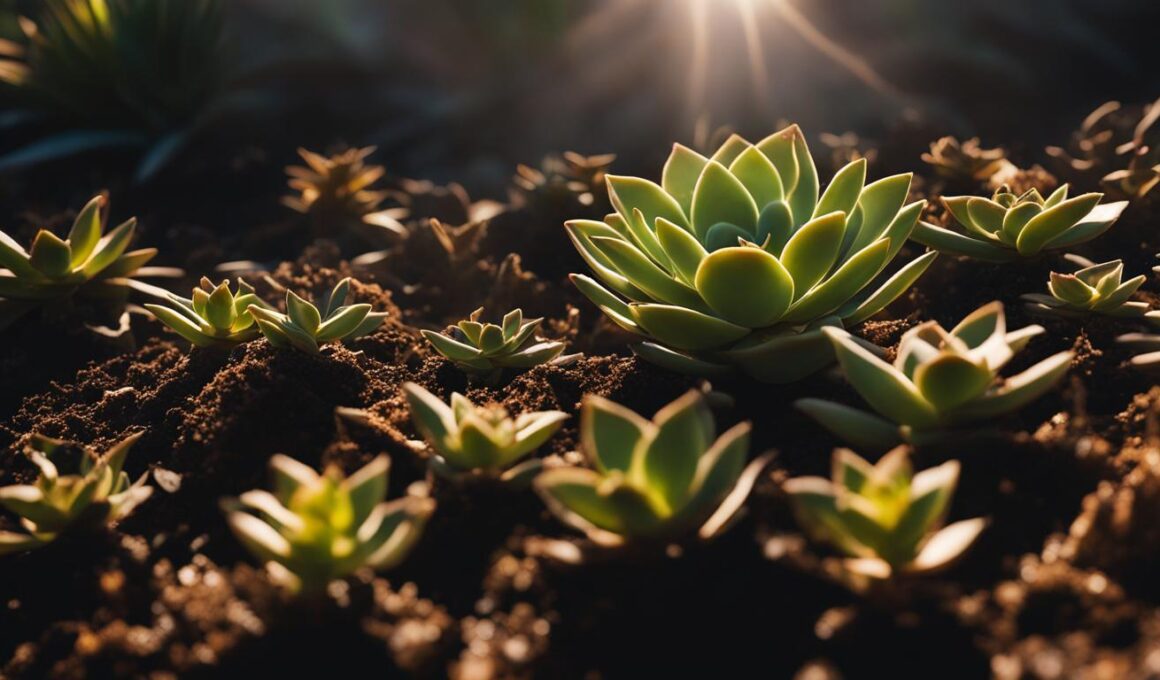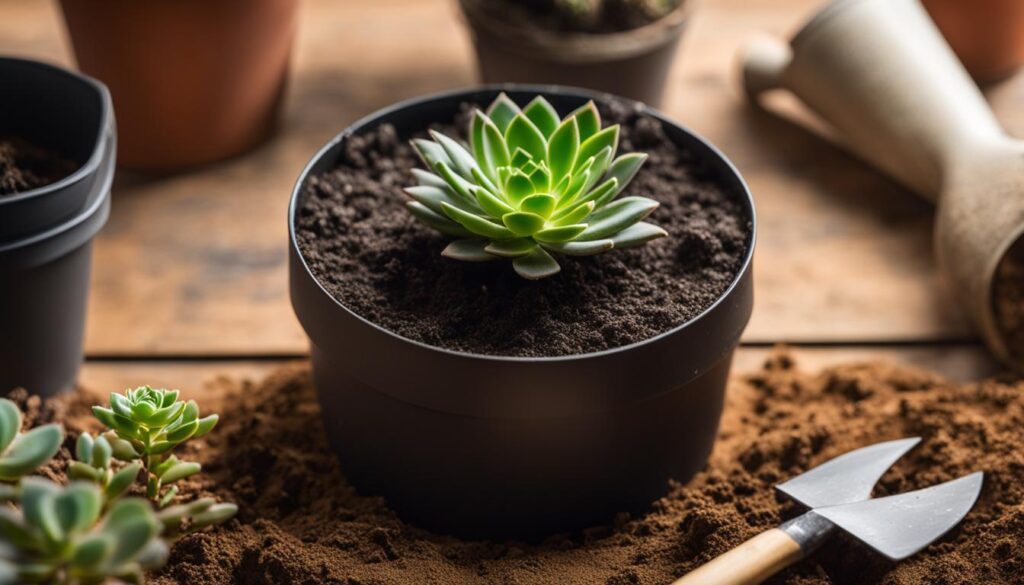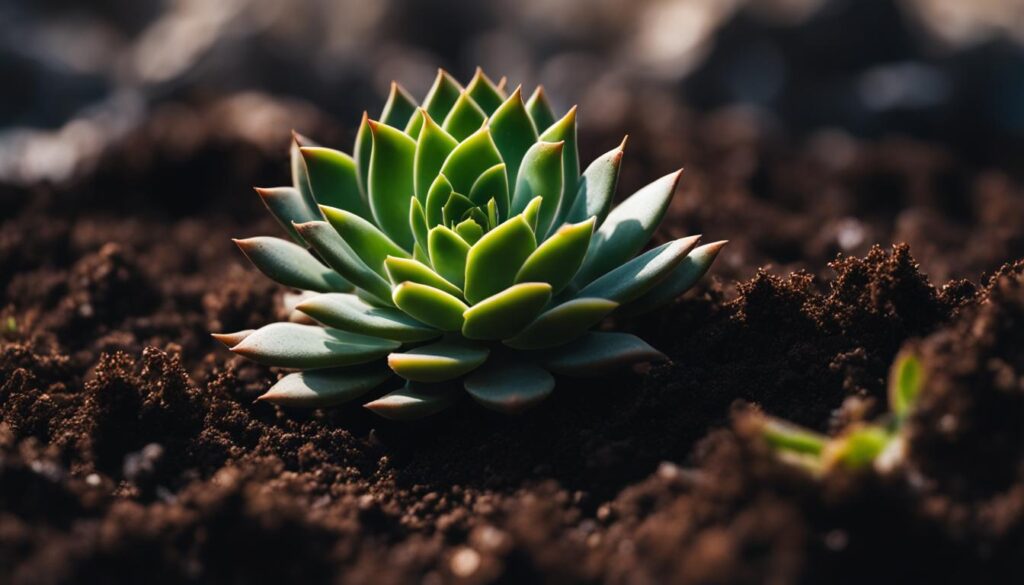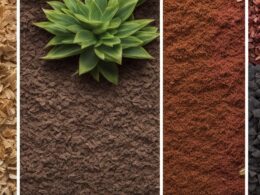Soil preparation is crucial when it comes to creating the ideal environment for succulents to thrive. The right pH balance, organic compost, and worm castings are key factors in enhancing soil for succulents. In this expert guide, we will explore soil preparation techniques, the importance of pH balance, and the benefits of incorporating organic materials into your succulent soil.
Key Takeaways:
- Soil preparation is essential for healthy succulent growth.
- Achieving the right pH balance is crucial for succulent soil.
- Organic compost and worm castings enrich the soil with essential nutrients.
- Well-draining soil is important for succulents to prevent root rot.
- Proper watering practices in hot climates promote strong root development.
Soil Preparation Techniques
In order to create a thriving environment for your succulents, proper soil preparation is essential. This involves ensuring the right pH balance, incorporating organic compost, and utilizing worm castings. By following these techniques, you can enhance the soil for succulents and promote healthy growth.
1. Achieving the Right pH Balance
The pH balance of your succulent soil plays a crucial role in determining its overall health. Aim for a pH range of 6.0 to 7.0, which is slightly acidic to neutral. This ensures optimal nutrient availability and root development. You can test the pH level of your soil using a simple home testing kit, and make adjustments if necessary.
2. Using Organic Compost
Organic compost is a valuable addition to succulent soil preparation. It enriches the soil with essential nutrients, enhances moisture retention, and improves soil structure. When incorporating organic compost, ensure it is well-rotted to prevent the risk of burning the roots. Mix it thoroughly into the soil, aiming for a ratio of approximately 1 part compost to 4 parts soil.
3. Harnessing the Benefits of Worm Castings
Worm castings, also known as vermicompost, are a nutrient-rich natural fertilizer produced by worms. They contain beneficial microorganisms that help break down organic matter and enhance nutrient availability to plants. When adding worm castings to succulent soil, mix them well into the soil or use as a top dressing. Aim to incorporate approximately 20% worm castings into your soil mixture for optimal results.
By implementing these soil preparation techniques, you can create an ideal growing medium for your succulents. Remember to regularly monitor and adjust the pH balance as needed, and continue providing organic compost and worm castings to nourish your plants. With the right soil, your succulents will thrive and bring beauty to your indoor or outdoor space.
| Succulent Soil Preparation Techniques | Benefits |
|---|---|
| Achieving the Right pH Balance | – Optimizes nutrient availability – Promotes healthy root growth |
| Using Organic Compost | – Enriches soil with essential nutrients – Improves moisture retention – Enhances soil structure |
| Harnessing the Benefits of Worm Castings | – Provides natural fertilizer – Enhances nutrient availability – Supports beneficial microorganisms |
Incorporating Compost and Worm Castings
In order to enhance the soil for your succulents and promote healthy growth, incorporating compost and worm castings can provide significant benefits. These organic materials play a crucial role in enriching the soil, improving nutrient availability, enhancing soil structure, and increasing water retention.
Compost is a valuable addition to succulent soil as it adds organic matter and essential nutrients, enriching the soil with a diverse range of beneficial microorganisms. This improves the overall fertility and health of the soil, creating an ideal environment for succulents to thrive. The organic matter in compost also helps to improve soil structure, allowing for better aeration and drainage, which is essential for succulents that are susceptible to root rot.
Worm castings, also known as vermicompost, are another excellent option for succulent soil enrichment. They are nutrient-rich, providing essential elements such as nitrogen, phosphorus, and potassium, which are vital for healthy plant growth. Worm castings also contain beneficial microbes that aid in breaking down organic matter, releasing nutrients in a form that the succulents can easily absorb. Additionally, worm castings improve soil structure and water-holding capacity, ensuring the soil retains enough moisture without becoming waterlogged.
The Benefits of Compost for Succulents:
- Enriches the soil with essential nutrients
- Improves soil structure and drainage
- Enhances the fertility and health of the soil
- Promotes the growth of beneficial microorganisms
The Benefits of Worm Castings for Succulents:
- Provides essential nutrients for healthy growth
- Improves soil structure and water retention
- Enhances nutrient availability
- Aids in the prevention of root rot
By incorporating compost and worm castings into your succulent soil, you can create an optimal environment that supports the growth and well-being of your plants. These organic materials provide essential nutrients, improve soil structure, and ensure proper moisture levels, ultimately leading to healthy and vibrant succulents.
Watering Tips for Succulents in Hot Climates
Watering succulents in hot climates requires special attention to prevent root rot and ensure their overall health. Succulents are known for their ability to store water in their leaves and stems, making them well-suited to dry conditions. However, extreme heat can increase water evaporation and deplete the moisture levels in the soil. By following the best watering practices for succulents, you can help them thrive even in hot climates.
One of the key tips for watering succulents in hot climates is to prioritize infrequent but deep watering. This means giving the plants a thorough soaking, allowing the water to penetrate deep into the soil. However, it’s important to let the soil dry out completely between waterings. This helps prevent root rot, a common issue caused by overwatering. Succulents prefer well-draining soil, so it’s crucial to ensure that excess water can easily escape.
“When watering succulents in hot climates, it’s essential to strike the right balance. You want to provide enough water to keep the plants hydrated but avoid overwatering, which can lead to root rot. Infrequent but deep watering, coupled with well-draining soil, is the key to success.”
Another useful technique for watering succulents in hot climates is to water early in the day. This allows the plants to absorb the moisture before the sun intensifies and evaporation rates increase. Watering in the morning also helps prevent water from sitting on the leaves for an extended period, reducing the risk of fungal diseases. Additionally, using a watering can or a drip irrigation system can help deliver water directly to the base of the plants, minimizing water wastage and maximizing absorption.
In conclusion, watering succulents in hot climates requires a careful balance between providing enough water to keep them hydrated and avoiding overwatering. By following the best watering practices, such as infrequent but deep watering, allowing the soil to dry out completely, and watering in the morning, you can help your succulents thrive in even the hottest of climates.
Reader Interactions and Expert Advice
In this section, we will delve into the intriguing world of succulent care and explore the questions posed by our readers. Our experts have provided valuable advice to address these concerns, ensuring that you have all the information you need to create the ideal soil for your succulents. Let’s dive in!
Reader Question: How often should I water my succulents?
“Succulents have unique water requirements. It is important to strike a balance to avoid overwatering or underwatering. As a general rule, water your succulents deeply but infrequently. Allow the soil to completely dry out between waterings. This helps promote strong root growth and prevents root rot,” advises our expert.
Additionally, our expert recommends using well-draining soil to prevent waterlogging. The ideal soil composition for succulents includes a mix of organic compost, coarse sand, and perlite. This blend ensures proper drainage, preventing water from lingering around the roots and causing rot or other issues.
Reader Question: Can I add fertilizer to my succulent soil?
“Fertilizing succulents can be beneficial, but it must be done in moderation. Too much fertilizer can lead to excess growth, which may result in leggy or weak plants. It is best to use a balanced, slow-release fertilizer specific to succulents. Apply it according to the instructions provided, usually once or twice a year,” advises our expert.
When fertilizing succulents, it is important to remember that less is more. Overfertilization can harm these hardy plants, so err on the side of caution. Always monitor your plants closely and adjust your fertilizing routine based on their individual needs.
Reader Question: What are the key ingredients for succulent soil?
“Succulent soil should be well-draining and provide sufficient aeration for healthy root development. A combination of organic compost, coarse sand, and perlite is commonly recommended. This mixture allows excess water to flow freely, preventing root rot and other moisture-related issues,” advises our expert.
It is important to note that different species of succulents may have slightly different soil preferences. Some may require a higher sand content for improved drainage, while others may appreciate the addition of peat moss for moisture retention. Understanding the requirements of the specific succulents in your collection will help you create the optimal soil mixture for their well-being.
Reader Question: How can I ensure my succulents thrive in different climates?
“Succulents are known for their resilience, but they do have varying tolerances to different climates. If you live in a hot climate, it is crucial to provide adequate shade and protection from intense sunlight. Consider using sunshades or planting succulents in areas with filtered light,” advises our expert.
Our expert also recommends selecting heat-tolerant succulent varieties and adjusting watering practices accordingly. In hot climates, it is even more essential to water sparingly and allow the soil to dry out between waterings. This helps prevent root rot and promotes the development of drought-tolerant roots.
By addressing these reader questions, we hope to have provided you with valuable insights and expert advice on succulent care and soil preparation. Remember, each succulent is unique, so understanding their individual needs and adjusting your care routine accordingly is key to their success.
Comments and Feedback From Readers
At [blog name], we value the feedback and comments from our readers. We appreciate the insights and questions that our community brings, as it allows us to continuously improve our content and provide you with the most relevant information. In this section, we’ll address some of the reader feedback we’ve received regarding succulent soil, as well as provide additional information on watering techniques for your succulents.
Many of our readers have expressed their appreciation for our previous articles on succulent soil preparation and enrichment. They found the tips and techniques provided helpful in creating the optimal soil conditions for their succulent gardens. Some readers also shared their personal experiences and success stories, which not only inspires us but also serves as a valuable resource for other succulent enthusiasts.
“I tried incorporating worm castings into my succulent soil mix after reading your article, and I’m amazed by the results! My succulents have healthier and more vibrant foliage now. Thank you!” – Reader from [location]
In response to the request for additional information on watering succulents, we have compiled some expert tips. When it comes to watering succulents, it’s important to strike the right balance. Succulents are adapted to survive in arid conditions, so overwatering can lead to root rot and other issues. It’s crucial to water sparingly, allowing the soil to dry out completely between waterings.
Remember to deep water your succulents to encourage the development of strong, drought-tolerant roots. When watering, make sure to soak the soil thoroughly, allowing the excess water to drain away. This ensures proper hydration while preventing waterlogged soil that can harm your succulents. Using well-draining soil that allows water to pass through easily is also essential in this process.
Table: Reader Feedback on Succulent Soil
| Name | Location | Feedback |
|---|---|---|
| Emily | Texas | “Your articles on soil preparation have been a game-changer for my succulents. I’ve seen significant improvements in their health and growth. Thank you!” |
| Michael | California | “I’ve been struggling with finding the right soil mix for my succulents, but your recommendations have been spot on. My plants are thriving now!” |
| Sarah | New York | “I never realized the importance of well-draining soil until I read your articles. Incorporating compost and worm castings has made a noticeable difference in my succulents’ health.” |
Additional Content and Resources
If you’re looking to learn more about enhancing the soil for your succulents, we’ve got you covered! Below, you’ll find a variety of additional resources and tips to help you create the perfect soil mix and provide the best care for your succulent garden.
Watering Tips for Succulents
Proper watering is essential for the health of your succulents. Overwatering can lead to root rot, while underwatering can cause the plants to become dehydrated. To help you find the right balance, here are some watering tips:
- Water sparingly: Succulents are adapted to survive in arid conditions, so they don’t require frequent watering. Allow the soil to dry out completely between waterings.
- Deep watering: When you do water your succulents, make sure to water them deeply. This encourages the development of strong, drought-tolerant roots.
- Well-draining soil: Succulents prefer soil that drains quickly to prevent root rot. Use a well-draining soil mix or amend your soil with perlite or pumice to improve drainage.
By following these watering tips, you can ensure that your succulents receive the right amount of water and thrive in your garden.
Creating the Perfect Soil Mix
Creating a well-balanced soil mix is crucial for succulent success. Here are some ingredients you can use to create the perfect soil mix:
- Succulent soil mix: You can find pre-made succulent soil mixes at your local garden center or online. These mixes are specifically formulated to provide the ideal drainage and nutrient balance for succulents.
- Perlite or pumice: Adding perlite or pumice to your soil mix helps improve drainage and prevents the soil from becoming compacted.
- Organic matter: Incorporating organic matter such as compost or worm castings can enrich the soil with essential nutrients and promote healthy root growth.
Experiment with different ratios of these ingredients to find the perfect soil mix for your succulents. Remember to avoid using regular potting soil, as it tends to retain too much moisture for succulents.
| Soil Ingredient | Benefits |
|---|---|
| Succulent soil mix | Provides ideal drainage and nutrient balance for succulents |
| Perlite or pumice | Improves soil drainage and prevents compaction |
| Organic matter (compost or worm castings) | Enriches soil with essential nutrients and promotes healthy root growth |
With the right watering techniques and a well-balanced soil mix, your succulents will have the best chance of thriving and adding beauty to your garden.
Reader Feedback and Additional Tips for Watering Succulents in Hot Climates
At the heart of successful succulent care lies a thorough understanding of watering techniques, especially in hot climates. We have received valuable feedback from our readers regarding watering succulents, and we are pleased to provide additional tips to help you keep your succulents thriving in the heat. Let’s explore some expert advice based on reader feedback to ensure optimal watering practices for your succulent garden.
Reader Insights and Tips
“I live in a desert area and struggle with watering my succulents. What can I do to prevent overwatering and ensure the right amount of water in the scorching heat?” – Sarah
Many succulent enthusiasts face challenges when it comes to watering in hot climates. To address Sarah’s concern and provide additional insights, here are some tips:
- Water sparingly: Succulents are native to arid environments, and they have adapted to thrive with minimal water. In hot climates, it is best to water less frequently but deeply. This allows the water to penetrate the soil and reach the roots, promoting healthy growth.
- Observe the soil: Before watering, always check the moisture levels of the soil. Stick your finger about an inch into the soil to determine if it is dry or still moist. Succulents prefer dry conditions, so avoid overwatering and allow the soil to dry out between waterings.
- Mulch and shade: To further conserve moisture and protect your succulents from extreme heat, consider applying a layer of organic mulch around the base of the plants. Additionally, providing shade during the hottest parts of the day can help prevent sunburn and keep the soil temperature cooler.
By implementing these tips, you can maintain healthy succulents even in the most challenging hot climates. Remember, succulents are resilient and adaptable, and with the right watering practices, they can thrive and bring beauty to your garden.
| Reader Feedback | Expert Tips |
|---|---|
| “I struggle with determining when to water my succulents in the heat.” | Check the moisture level of the soil regularly, and only water when it is dry. Succulents prefer to be slightly underwatered than overwatered. |
| “Can I use a spray bottle to water my succulents in hot climates?” | Avoid using a spray bottle as it provides shallow watering. Instead, use a watering can or a hose to ensure deep watering that reaches the roots. |
| “How can I protect my succulents from intense sunlight?” | Consider providing shade during the hottest parts of the day or using shade cloth to protect your succulents from sunburn. |
Additional Content and Resources
In order to create optimal soil conditions for your succulents, it is important to have access to additional resources that provide valuable insights and tips. Whether you are a beginner or an experienced succulent enthusiast, these resources can help you enhance your knowledge and ensure the success of your succulent garden.
One useful resource is the Succulent City website, which offers a wealth of information on succulent care, including soil preparation techniques and specific soil ingredient recommendations. Their comprehensive guides and articles cover various aspects of succulent cultivation, providing detailed step-by-step instructions for creating the perfect soil mix tailored to your succulent’s needs.
Another valuable resource is the book “Succulents Simplified” by Debra Lee Baldwin. This informative guide offers a wealth of knowledge on succulent care, including soil preparation, watering techniques, and general maintenance tips. It also features beautiful photographs and illustrations that can inspire and guide you in creating optimal soil conditions for your succulents.
In addition to online resources and books, joining succulent communities and forums can provide you with valuable insights and advice from fellow enthusiasts. These platforms allow you to interact with experienced succulent growers, ask questions, share experiences, and learn from others. Websites such as Reddit’s r/succulents and Facebook’s Succulent Lovers Group are popular communities where you can connect with like-minded individuals and gain valuable knowledge on succulent care, including soil optimization.
By accessing these additional resources, you can further enhance your understanding of succulent care and create the optimal soil conditions for your plants. Remember to consider the specific needs of your succulents, such as their water requirements and environmental conditions, when applying the advice and techniques provided. With the right soil preparation and care, your succulent garden can flourish and bring you joy for years to come.
Additional Content and Resources
Now that you have learned about the importance of soil preparation and incorporating compost and worm castings for your succulents, it’s time to explore additional resources and tips for maintaining a healthy succulent garden. Below, you will find a list of useful resources and expert advice to help you enhance your succulent’s soil and create an optimal growing environment.
Additional Resources
- Succulents and Sunshine – A comprehensive website offering a wealth of information on succulent care, including soil preparation techniques, watering tips, and specific recommendations for succulent soil ingredients.
- Best Soil for Succulents – Succulents and Sunshine – A detailed guide on selecting the best soil mix for your succulents, including information on pH balance, soil structure, and moisture retention.
- Succulent Soil Recipes – The Spruce – A collection of succulent soil recipes that you can easily create at home, ensuring the perfect blend of nutrients and drainage for your succulents.
These resources provide valuable insights into creating a healthy succulent garden and offer step-by-step guidance on achieving optimal soil conditions for your beloved plants. Remember to tailor your soil mixtures based on the specific needs of your succulents and the environmental conditions in your area.
With the right resources and tips at your disposal, you’ll be well-equipped to care for your succulents and create a thriving garden that brings you joy for years to come.
Can Xeriscaping Techniques also Improve Soil for Succulents?
Yes, xeriscaping techniques for water conservation can also improve soil for succulents. By using methods such as mulching, composting, and proper irrigation, xeriscaping can create well-draining, nutrient-rich soil ideal for succulent growth. This approach promotes water efficiency while promoting healthy plant growth.
Conclusion
In conclusion, enhancing the soil for your succulents is crucial for achieving healthy succulent growth. This expert guide has provided you with valuable insights and techniques to create the perfect soil conditions for your succulent garden.
By following the soil preparation techniques discussed in this article, such as maintaining the proper pH balance, incorporating organic compost, and adding worm castings, you can ensure that your succulents receive the essential nutrients they need and promote healthy root growth.
Remember to seek advice from experts and fellow enthusiasts when it comes to succulent care and soil preparation. With the right soil mix, you can create an optimal environment for your succulents to thrive for years to come, bringing beauty and joy to your garden.














